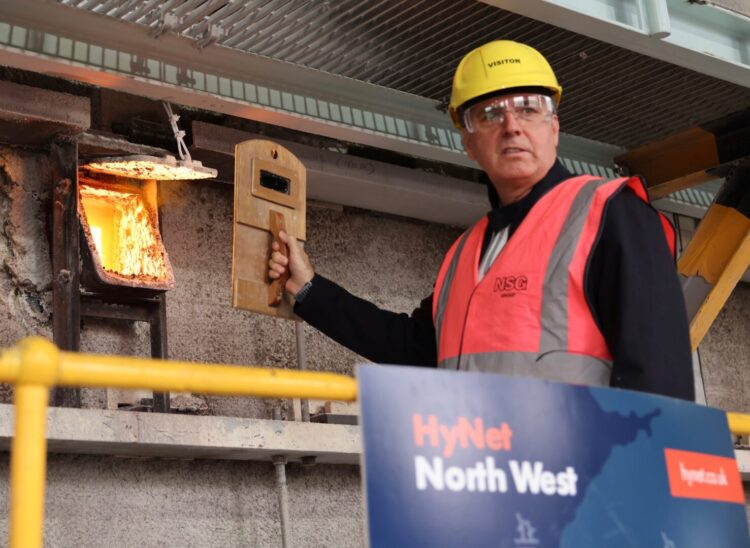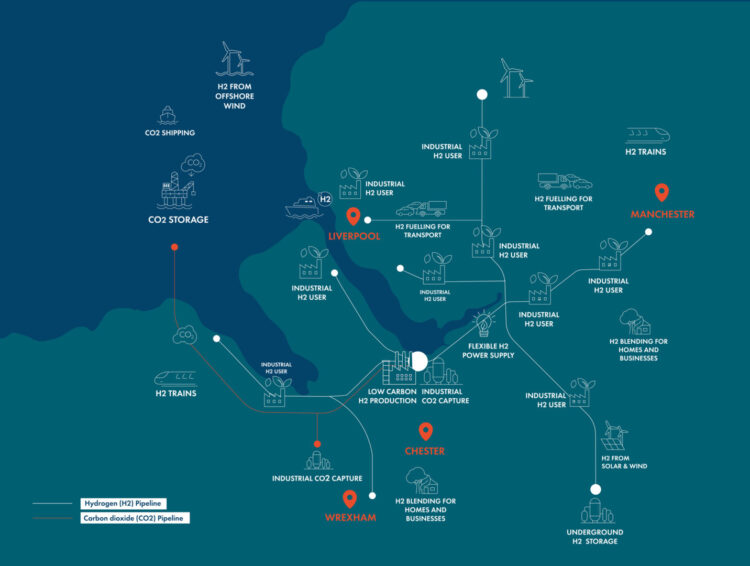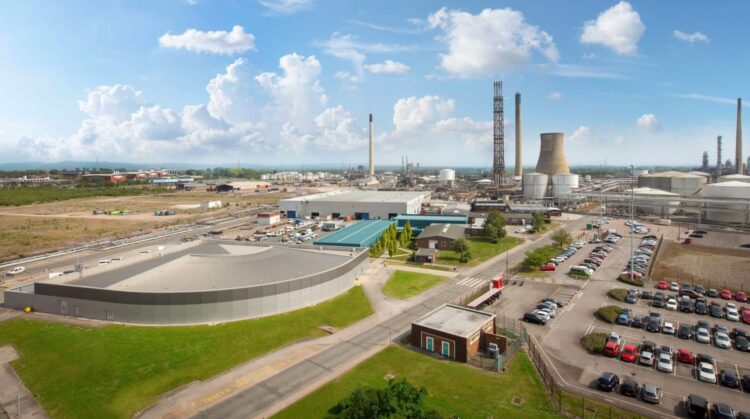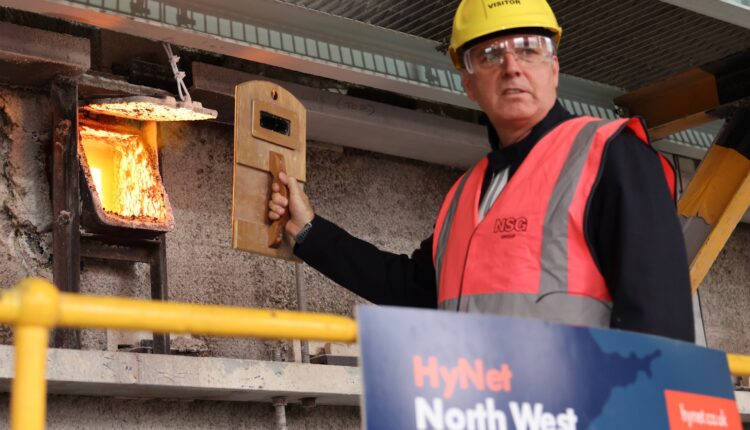On Tuesday Liverpool City Region Metro Mayor Steve Rotheram welcomed the Government’s backing of the HyNet hydrogen project – but is it achievable and can it deliver on its promises? Tony McDonough reports

On Tuesday the Government gave its backing to the multi-billion pound HyNet project that will offer low carbon hydrogen fuel for industry and transport across the North West.
HyNet will see the creation of multiple facilities across the North West and North Wales that will produce “clean hydrogen” to replace the fossil fuels we use today for industry, transport and homes. It could create around 6,000 jobs.
It will capture and store carbon dioxide (CO2) emissions produced by energy intensive industries. HyNet claims it will be up and running by 2025. A pilot project at the Pilkington glass factory in St Helens is already under way. A second pilot, at the Unilever factory in Wirral, is also due to begin later this year.
Following that is a plan by Liverpool City Region Metro Mayor Steve Rotheram to introduce a 20-strong fleet of hydrogen-powered buses onto the 10A route which runs between Liverpool city centre and St Helens. A hydrogen fuelling station would be located in St Helens.
This latest Government support for HyNet means the project could start decarbonising the North West and North Wales from 2025, reducing annual CO2 emissions by an estimated 10m tonnes by 2030.
Mr Rotheram was delighted with the news. He said: “Today’s decision is a massive show of confidence from the Government that the north can lead the country’s transition to net zero – with our region front and centre.
“I’ve been a longstanding and passionate advocate of HyNet, for its revolutionary approach to clean, green energy, and for its capacity to protect and create thousands of high-skilled, high-paid jobs across the region.
“And it is the Liverpool city region that is at the heart of HyNet, from pioneering trials of new technology in St Helens and the Wirral, to carbon storage in Liverpool Bay. When it is up and running in 2025, it will provide a huge boost to our economy and our ambitious net zero targets.”
He adds the estimate that HyNet could also generate up to £31bn for the UK and will single-handedly deliver 80% of the UK’s clean power targets by the end of the decade.
“It is my ambition for our region to be at the forefront of the green industrial revolution,” he said. “Leading the charge towards net zero, and taking advantage of the myriad of jobs, investment and opportunities that it provides.”
Last week Essar Oil (UK) unveiled plans to build two hydrogen plants at its giant oil refinery at Stanlow, close to the Mersey, with a combined investment value of £750m as part of HyNet. Chief executive Deepak Maheshwari welcomed the Government’s decision.
He said: “This is a transformative decision which further boosts Essar’s growing momentum as we transition to low carbon operations, continue to invest in Stanlow’s evolution to power the UK’s post-carbon economy and regenerate regional growth.”

However, the delivery of the project may not be as straightforward as it first seems. Critical to the success of the HyNet network is a process known as carbon capture and storage (CCS).
A £1bn fund has been created to build this infrastructure which would include a facility to capture the carbon close to Chester with the carbon being stored under the sea bed in Liverpool Bay. But the success of large scale CCS across the world is patchy and results have been disappointing and expensive.
There is also a further question of how much carbon will actually be saved by HyNet. Initially the project will produce something called ‘blue hydrogen’ and the environmental benefits have been questioned by some experts.
According to the International Energy Agency, 96% of hydrogen produced across the world each year is made using fossil fuels, including coal, oil and natural gas. In a process called ‘reforming’ fossil fuels are mixed with steam and heated to 800°C. This process produces carbon dioxide ((CO2) and hydrogen.
When the two are separated the CO2 usually ends up being released into the atmosphere and contributing to the dangerous build-up of greenhouse gasses. The extracted hydrogen can be stored indefinitely and used in a variety of ways. All that is released at the end of the process is water vapour.
There are three main methods of producing hydrogen. They are:
Grey hydrogen
This method of producing hydrogen offers no environmental benefit. Grey hydrogen is generated from natural gas, a very commonly-used fossil fuel, comprising methane and ethane, which you will find in your gas boiler or kitchen stove at home. So the CO2 emissions from this process are huge.
According to HyNet the glass-making pilot at Pilkington in St Helens will be using grey hydrogen supplied by BOC.
David Parkin, HyNet project director, told LBN: “The purpose of the trial is to demonstrate the safe and reliable use of hydrogen in the manufacturing environment, such that when low carbon hydrogen is available in the future the transition from natural gas can be made.”
Blue Hydrogen
Blu hydrogen is key to the initial phases of HyNet, although there is a plan to use ‘green hydrogen’ (see below) further down the line.
It has the same starting point as grey hydrogen, burning natural gas. Instead of being released into the air and contributing to the greenhouse effect, the CO2 is captured and stored.
Sounds simple? In practice it has been far from straightforward. The Gorgon CCS project off Western Australia has not delivered on its initial promises. Gorgon is a large offshore gas field operated by Chevron. Most of the gas is liquefied and exported to Asia.
CO2 can cause damage to equipment so needs to be separated. Rather than releasing it into the atmosphere, the project looks to capture it and inject it back into the sandstone from where the gas was extracted.
It started in 2009 with CCS intended to begin in 2016. However, the first CO2 was not injected until 2019. The problem is the process creates pressure, causing the CO2 to eventually escape. So far, only 2.5m tonnes a year are being stored, lower than the 4m tonnes promised, making it significantly more expensive.
Another project, at a gas field in Salah in central Algeria, aimed to separate and store 1m tonnes of CO2 a year running until 2027. It started in 2004 and was abandoned in 2011 with the pressure caused by injecting CO2 into sandstone also causing leaks.
The conclusion is that success is very dependent on geology and may be more expensive than anticipated.
Green hydrogen
As the name suggests, green hydrogen is the best option of all for slashing carbon emissions and meeting our climate change targets. It generates hydrogen via wind or solar energy, using a process called electrolysis, and is emission-free.
This is not yet widely available at scale or at an affordable cost but the availability of offshore wind energy in Liverpool Bay does offer the potential for green hydrogen to play a central role in HyNet’s future plans.



Other experts have also questioned how effective blue hydrogen, critical to HyNet’s success, is at cutting carbon emissions. In the summer, a report from Cornell, one of the leading universities in the US, considered this question.
Robert Howarth, professor of ecology and environmental biology, together with Mark Z Jacobson, professor of civil and environmental engineering at Stanford, were the authors of the study.
Prof Howarth said: “In the past, no effort was made to capture the carbon dioxide byproduct of grey hydrogen and the greenhouse gas emissions have been huge. Now the industry promotes blue hydrogen as a solution.
“This is an approach that still uses the methane from natural gas, while attempting to capture the byproduct carbon dioxide. Unfortunately, emissions remain very large.”
He explained that methane is an even more powerful greenhouse gas than CO2. It is more than 100 times stronger as an atmospheric warming agent than carbon dioxide when first emitted.
Methane is released when the natural gas is extracted and also leaks during the process. Also, not all the CO2 is captured. Between 5% and 15% escapes. The report acknowledges that blue hydrogen is a better option than grey hydrogen but claims it will only lower greenhouse emissions by between 9% and 12%.
It states: “Blue hydrogen as a strategy only works to the extent it is possible to store carbon dioxide long-term indefinitely into the future without leakage back to the atmosphere.”
And Prof Howarth added: “Political forces may not have caught up with the science yet. Even progressive politicians may not understand for what they’re voting. Blue hydrogen sounds good, sounds modern and sounds like a path to our energy future. It is not.”
Blue for you
In a statement to LBN in late August, David Parkin of HyNet told LBN: “HyNet hydrogen production uses ‘blue’ hydrogen technology, as this offers the best route to supplying low carbon hydrogen at scale in the short to medium-term.
“However, HyNet’s hydrogen pipeline and storage infrastructure is designed such that low carbon hydrogen of all types, including green hydrogen, can be distributed to industry, transport and homes when it becomes available.”
Following Tuesday’s announcement he said: “The project partners are ready to deliver and, as one of the first industrial decarbonisation clusters, we will play a big part in shaping the country’s hydrogen economy, positioning the UK as a global leader in the sector.
“We are looking forward to working closely with the Government and the other clusters to deliver and grow the infrastructure as rapidly as possible, both in breadth and depth, over the coming years.”

